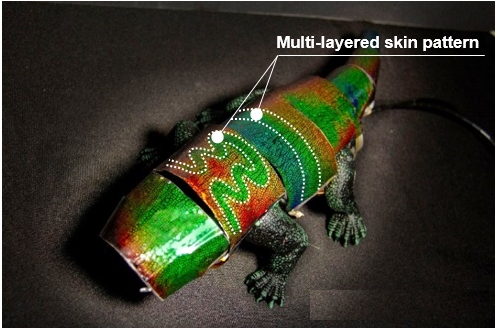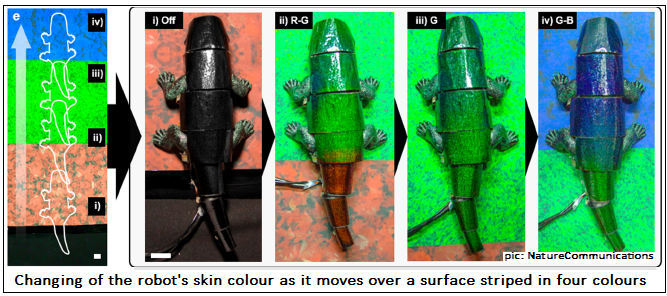Doing it like the chameleon, says S.Ananthanarayanan.
Camouflage is the strategy of nature. Armies use camouflage in defence and in attack and there are many fields where merging physically with the environment is an advantage.
In the natural world, however, to stay unseen is an imperative. The hunted need to stay out of sight. And predators cannot be successful if their presence is discovered by their prey. A classic instance of staying hidden is that of the butterfly, Kallima_inachus, which is black, orange and blue, when the wings are open, but resembles a dead leaf when the wings are closed (see the picture). And as for predators, few can match the crocodile, which floats at the edge of a pond, like a log, till an animal comes there to drink!

Hyeonseok Kim, Joonhwa Choi, Kyun Kyu Kim, Phillip Won, Sukjoon Hong and Seung Hwan Ko, from Seoul National University and, Hanyang University, in Korea, describe in the journal, Nature Communications, an artificial surface that mimics nature’s leader in adapting its appearance to surroundings, the chameleon’s capacity to rapidly change colours.
The colours in nature arise either due to pigments or the structure of surfaces. The colours of flowers and leaves, and even of animal skin, are because of the chemicals that they contain. Most of the colour-related action is in cells that contain pigment, which can be red, dark, as in black or yellow. And there are animals, particularly marine animals, that can control the pigments expressed, they are able to bring about an extent of changes in colors. Many marine species also have fluorescent or bioluminescent scales. The squid is even known to harbor bacteria that glow to match a well-lit background, and avoid being seen by predators.
The changes in colors of the chameleon was considered to arise from dispersion, or the coming together, of light-reflecting cells which contain pigments. But some species of chameleon show great variations of colour, not just of shade. As this cannot arise by only changing the distribution of pigment-carrying cells, scientists have looked deeper. It has been found that the skin of the male chameleon contains two layers of a mesh of minute crystals, which have no affinity to colors, but whose orientation and separation affects the shades of light that the skin reflects. The chameleon’s ability to rapidly change colours is through muscular changes in the distances between the nanocrystals, which changes the wavelengths of light that are strongly reflected by the animal’s skin.
Artiificial camouflage
Developing an artificial camouflage system that compares with the standard that the chameleon has set presents a huge challenge, the Nature Communication paper says. The paper recalls that ever since the 1800s, there have been efforts to develop technology that could help the military, either to evade detection or to see through camouflage used by the enemy. And surface covers that would match the background, either in colour or a pattern, have been the objectives. And the challenge - even just for matching the background colour, the device used would need to cover the visible spectrum, and it would need to switch colours with the least delay.
One way to meet the requirements would be to build each pixel to contain a panel of devices, one for each colour. For reasonable resolution, however, the devices would need to be densely packed. And the device itself, it needs to be flexible and mechanically robust. All this, and the need to sense the colour of the background, and communicate with individual units, leads to an explosive increase in the system complexity, the paper says.
The solution that the team in Korea has found is to build the surface with an ink that changes colour according to temperature – consisting of what are termed as thermochromatic liquid crystals (TLC). The TLC is a device that changes colour, depending on the temperature. So far, the TCL is mainly used as a ‘non-invasive temperature indicator’, for example of moving liquids. But the material has a range that covers the visible spectrum, and, the paper says, the TLC has been acknowledged as a potential candidate for artificial camouflage applications.
In the work of the Korean group, the TLC layer is backed by a stack of transparent sheets that carry silver nanowire heaters. With patterning of the nanowires, it is possible to control temperature at individual spots of the TLC layer, to display desired colours. Once a proper control circuit is provided, the paper says, it becomes possible to have sensitive temperature management, and without the need for packing individual units for pixels of each colour. “The silver nanowire has excellent electrical conductivity and oxidation resistance as a single material and has a cost-effective feature to be applied for large-area applications through a simple synthesis process,” the paper says. The electrical resistance varies according to temperature, and this becomes a way to know the temperature of a nanowire heater, so that the temperature can be controlled, which “permits a further reduction in the response time even to be comparable to the physiological color change found in animals,” the paper says.
Using these ideas, the Korean team has created a robotic chameleon, a model that is equipped with the silver nanowire and TLC-based, Artificial Chameleon Skin, and then with color sensors and feedback control systems. The result is an “adaptive artificial camouflage….device which is capable of detecting the local background color and matching its coloration in real-time,”, the paper says.

The team recognizes that in most habitats, it is only the background colour that needs to be matched, not a complicated image. With this in mind, in place of constructing a large number of heater elements, the layers were built with void areas and patterned according to common habitats. Stacking of such layers allowed simultaneous colour matching and expression of the microhabitat, and with greatly reduced complexity of construction.

The technology developed could have applications in diverse areas, architecture, art and fashion, consumer products, apart from military applications.
------------------------------------------------------------------------------------------ Do respond to : response@simplescience.in-------------------------------------------